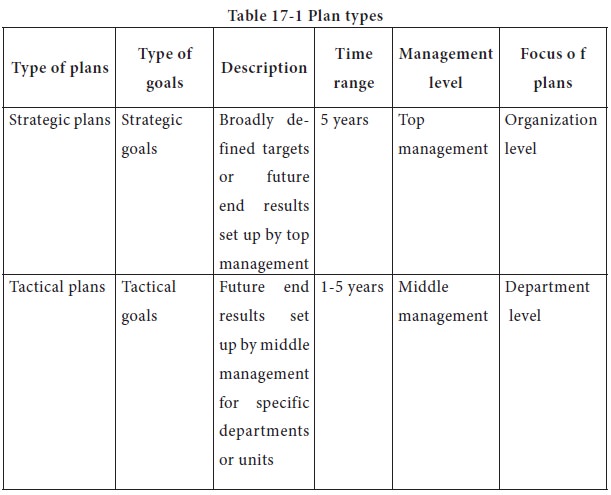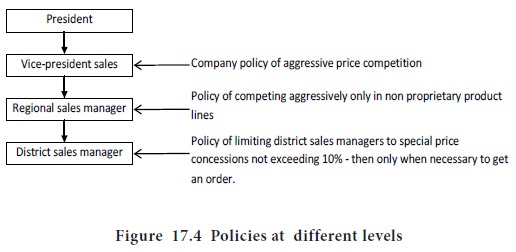Strategic Management - Strategy Implementation
Types of Plans - Planning And Resources Allocation
The failure of managers to recognize that there are several types of plans has often caused difficulty in making planning effective.
The failure of managers to recognize that there are several types of plans has often caused difficulty in making planning effective. Plans encompass any cause of future action and hence vary as under.
Purposes or missions
Identifies the basic task of a firm or agency. Ex. Purpose of business is the production and distribution of goods and services
Dupont | - | Better
things through chemistry |
Kleenex | - | Production
and sale of |
paper
& products | ||
Hallmark | - | Social
expression of business |
J &
J | - | First
responsibility to doctors, |
nurses,
patients and mothers | ||
Dow
chemical | - | Sharing
world’s obligation for |
the
protection of the environment |
Conglomerates express their mission as ‘synergy’ which is achieved through combination of a variety of companies.
Therefore mission is the organization’s purpose and fundamental reason for existence. A mission statement is the broad declaration of the basic. Unique purpose and scope of operations distinguish the organization from others.
Objectives and goals
Planning aims at goal setting. Goals and objectives are ends towards the activity aimed. They represent the end toward organizing, staffing, leading and controlling. Each department may have its own goals, which contribute to objectives of organizations as illustrated below.

Goals
serve many purposes like the following |
| |||||||
*
Increase performance | *
Clarify expectations |
| ||||||
*
Facilitate the controlling function | *
Increased motivation |
| ||||||
Goals
have levels that compare with hierarchy of organization as depicted in Table 17 - 1. | ||||||||
| ||||||||


Peter F.
Drucker gives eight
major areas for
goal setting by organizations. | |||||||
*Market
standing | *Innovation | ||||||
*Human
resources | *Financial
resources | ||||||
*Physical
resources | *Productivity | ||||||
*Social
responsibility | *Profit
requirements | ||||||
Strategies | |||||||
Strategies are grand plans in the light of what it was believed an adversary might or might not do. Strategy may be defined as follows. “Strategy is the determination of basic long term objectives of an enterprise and the adoption of courses of action and allocation of resources necessary to achieve these goals”.
A strategy might include such as marketing directly rather than through distributors or concentrating on proprietary products of having a full time of autos ex: General Motors.
Strategies are of two types
Generic strategies - involve organization expansion in some select areas. The generic strategies include –
1. Overall cost leadership
2. Differentiation
3. Focus
Grand strategies - A master strategy that provides direction at the corporate level

Policies
Policies are plans or general statements or understandings that guide or channel thinking in decision making. Policies define an area in which decision is to be made and ensure consistency to objectives. Policies help managers maintain control and delegate authority.
Policies exist at all levels in an organization. They may be major or minor. Policies include hiring trained engineers, encouraging employee suggestions, confirming to high standards, setting competitive prices, cost plus pricing etc. Companies can have policy manuals which may stipulate non-acceptance of gifts from suppliers, favours of entertainment or seek outside employment.
Making policies is difficult for
1. They are seldom defined in writing
2. Delegation of authority will create confusion
3. Actual policy may be difficult to ascertain and intended policy may not be clear.
Policies are necessary at different hierarchical levels as shown in Figure 17-4

Procedures
Procedures are plans that establish a required method of handling future activities. They are guides to action, rather than thinking and they detail the exact manner in which certain activities must be accomplished. Procedure is thus a prescribed series of steps to be taken under certain recurring circumstances. Well-established ones are called ‘Standard Operating Procedures’. Ex: In Banks SOPs govern how tellers handle deposits.
The following procedures are common and are across different departments.
Production
Department | - | release
of stock |
Traffic
Department | - | shipping
means & route |
Finance
Department | - | customer
credit approval, |
acknowledgement
receipts | ||
Marketing
Department | - | for
original order |
Rules
“A statement that spells out specific actions to be taken or not taken in a given situation”
Unlike procedures, rules do not normally specify a series of steps. They dictate what must or must not be done.
Ex: 1. “No Smoking” is a rule unrelated to procedure.
Policies guide decision making, but rules allow no discretion in decision making.
Programmes
Programmes involve different departments or units of organization composed of several different projects which may take about one year to complete. Programme may be defined as follows.
“A programme is a comprehensive plan that coordinates a complex set of activities related to a major non recurring goal”.
“Programmes are a complex of goals, policies procedures, rules, task assignments, steps to be taken, resources to be employed and other elements necessary to carry out a given course of action supported by budgets”.
Examples of programmes are
1. A major airline acquiring $400 million fleet of jets
2. Five year programme to improve status and quality of supervisors.
i. Dividing the project into parts
ii. Determining relationships and pulling in a sequence
iii. Deciding responsibilities for mangers
iv. Determining how to complete and what resources are necessary
v. Estimating time requirements
vi. Developing a schedule of implementation
A primary programme may trigger off a series of small programmes.
Budgets
Budget is a numberized programme. It can be defined as follows.
“Budget is a statement of expected results expressed in numerical terms”
Budget can be expressed in financial terms, labour hours, units, machine hours etc. It may show expenses, capital outlays, cash flows etc.
A budget is a fundamental planning instrument. Budget forces precision in planning.
• | Flexible/variable
budgets | - | vary
according to the level of | ||
output | |||||
• | Programme
budgets | - | an
agency to identify goals, | ||
develop
programmes to meet them and give cost estimates. | |||||
• | Operating
budget | - | A finance | plan for | each |
responsibility
during budget period. | |||||
• | Capital
budget | - | Budget for | Mergers | & |
Acquisitions,
divestiture of fixed assets. | |||||














